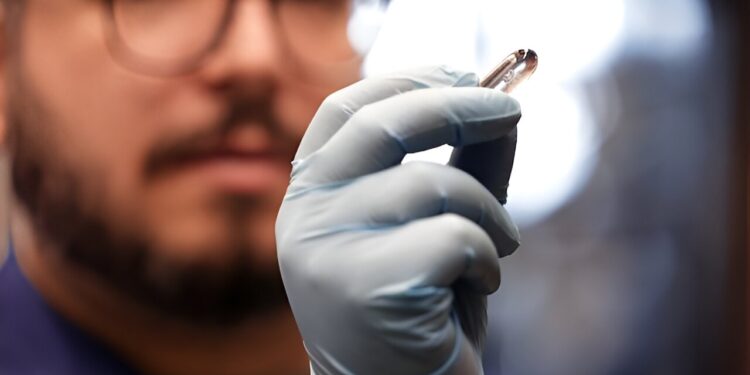Abdon Pena-Francesch holds the soft gel before it is treated with chemicals that give the material its magnetic properties. The colorless precursor can be molded into various forms, such as capsules that could one day be ingested to deliver medications. Credit: Brenda Ahearn/Michigan Engineering
Next-generation “soft robots,” medical devices and implants, and drug delivery methods could soon be guided by magnetism, thanks to a metal-free magnetic gel developed by researchers at the University of Michigan and the Max Planck Institute for Intelligent Systems in Stuttgart. , Germany.
This material is the first in which carbon-based magnetic molecules are chemically bonded to the molecular network of a gel, creating a flexible and durable magnet for soft robotics. The study describing the material was published today in the journal Matter.
Creating robots from flexible materials allows them to contort themselves in unique ways, manipulate delicate objects, and explore places that other robots cannot. More rigid robots would be crushed by the pressure of the ocean depths or could damage sensitive tissues in the human body, for example.
“If you make robots soft, you have to find new ways to give them power and make them move so they can work,” said Abdon Pena-Francesch, assistant professor of materials science and engineering. affiliated with the University of Michigan Robotics Institute and a corresponding author of the study
Today’s prototypes typically move using hydraulic or mechanical cables, which require the robot to be attached to a power source or controller, which also limits its range. Magnets could release these robots, allowing them to be moved by magnetic fields.
Conventional metal magnets, however, introduce their own complications. They could reduce the flexibility of soft robots and be too toxic for certain medical applications.
The new gel could provide a non-toxic alternative for medical operations, and additional changes to the magnet’s chemical structure could help it degrade in the environment and in the human body. Such biodegradable magnets could be used in capsules guided to targeted locations in the body to release drugs.
“If these materials can degrade safely in your body, you won’t need to recover them later through another surgical procedure,” Pena-Francesch said. “It’s still quite exploratory, but these materials could one day enable newer, less expensive medical operations.”
The team’s gel consists only of carbon-based molecules. The key ingredient is TEMPO, a molecule with a “free” electron that is not associated with another electron within an atomic bond. The spin of each unpaired TEMPO electron in the gel aligns under a magnetic field, which attracts the gel toward other magnetic materials.
Additional “cross-linking molecules” in the gel act as a framework that connects the TEMPO molecules to a solid network structure while forming a protective cage around the TEMPO electrons. This cage prevents unpaired electrons from forming bonds, which would remove the magnetic properties of the gel.
The chemical structure of the organic magnet. The brown lines and black nodes show the general arrangement of the “cross-linking molecules” that serve as a framework for the molecular structure of the gel and a cage for the TEMPO molecules (shown in red). TEMPO molecules are linked directly to the gel structure. The free electrons on the TEMPO oxygen atoms (represented by dots) give the material its magnetic properties. Credit: Abdon Pena-Francesch/BioInspired Materials Lab, University of Michigan
“Previous studies have soaked these small magnetic molecules in a gel, but they could escape from the gel,” said Zane Zhang, a doctoral student in materials science and engineering and co-author of the study. “By integrating the magnetic molecules into the cross-linked gel network, they are fixed inside.”
Locking the TEMPO molecules inside the material ensures that the gel does not leak potentially harmful TEMPO molecules into the body and allows the material to retain its magnetic properties for over a year.
Although weaker than metal magnets, TEMPO magnets are strong enough to be pulled and bent with another magnet. Their weaker magnetism also has some advantages: TEMPO magnets can be photographed by an MRI, unlike stronger magnets which can distort MRI images to the point of rendering them useless.
“Medical devices using our magnets could be used to deliver drugs to target locations and measure tissue adhesion and mechanics in the gastrointestinal tract under MRI imaging,” said Metin Sitti, former director of the Department of physical intelligence at the Max Planck Institute for Intelligent Systems and a corresponding author of the study.
More information:
Abdon Pena-Francesch et al, Macromolecular radical networks for organic soft magnets, Matter (2024). DOI: 10.1016/j.matt.2023.12.015
Provided by University of Michigan
Quote: Spongy, metal-free magnets to power robots and guide medical implants (January 16, 2024) retrieved January 16, 2024 from
This document is subject to copyright. Except for fair use for private study or research purposes, no part may be reproduced without written permission. The content is provided for information only.



